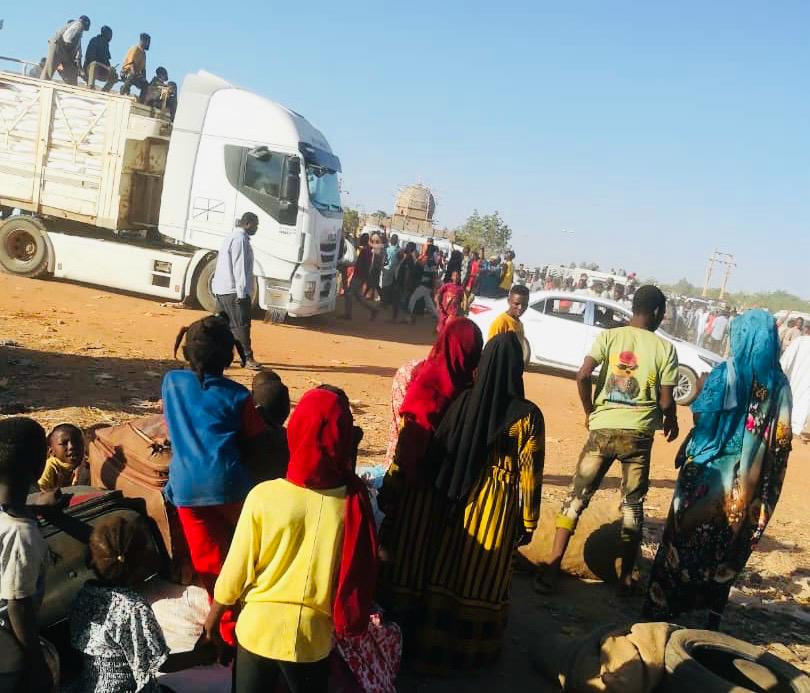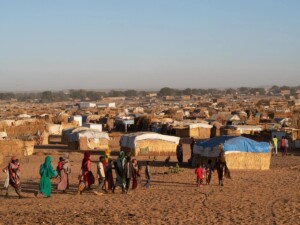Sudan humanitarian situation tops IRC Emergency Watchlist for 2024

Civiliams fleeing the war from El Gezira to El Gedaref, Kassala, Sennar, and Blue Nile (File photo: RD)
The flow of displaced people from El Gezira to eastern and northern Sudan continues. They face difficult humanitarian conditions due to overcrowded shelters and limited services. Sudan topped this year’s International Rescue Committee’s watchlist of countries most likely to experience a deteriorating humanitarian crisis.
A resident of Port Sudan told Radio Dabanga that the shelter centres, primarily located in schools, are “filled with people displaced from El Gezira”.
Many of them fled twice, the first time from Khartoum following the outbreak of battles between the Sudan Armed Forces (SAF) and the paramilitary Rapid Support Forces (RSF) on April 15 last year, and the second time when the RSF took control of El Gezira on December 19.
The displaced are living in difficult conditions due to insufficient food and shelter supplies, the source said, noting that many struggle to find adequate places for shelter.
Rental prices in eastern Sudan (Red Sea state, Kassala, El Gedaref) and River Nile state in the north surged dramatically compared to the period before the war erupted on April 15 last year.
A listener described the living conditions as difficult, citing high prices and a scarcity of funds for most people due to the non-payment of salaries for several months.
The cost of renting a one-bedroom house with a living room ranged from SDG500,000 to SDG1 million*, he said. In some neighbourhoods in Port Sudan, prices have reached SDG1.5 million and beyond.
“The high rental prices forced many displaced families to leave the homes they previously rented and live in shelters, schools, and other complexes.”
‘Extreme’
Sudan tops the International Rescue Committee’s (IRC) 2024 Watchlist of countries likely to experience further deterioration in humanitarian conditions. IRC refers to the classification by the Geneva-based Assessment Capacities Project (ACAPS) of the humanitarian situation in Sudan as “extreme”.
The committee said yesterday in its report Crisis in Sudan: What is happening and how to help that Sudan leads the list this year due to the escalation of conflict, mass displacement, the worsening economic crisis, and the almost collapse of healthcare services.
Before the conflict, Sudan faced a severe humanitarian crisis due to ongoing political instability and economic pressures. 15.8 million people needed humanitarian assistance, and now more than half of the population, 25 million people, require aid.
More than 12,000 people have been killed, and approximately 7.2 million people were displaced from their homes, half of whom are children, since making it the largest displacement crisis globally.
The conflict’s expansion into El Gezira, ‘Sudan’s breadbasket’, has displaced more than 500,000 people and exacerbated the country’s food crisis. Meanwhile, looting of businesses, markets, and relief stores is exacerbating food shortages.
Following the fall of El Gezira to the RSF, the IRC and other humanitarian organisations were compelled to relocate their staff from Wad Madani, the capital.
Displacement
The majority of those displaced by the current conflict remain within Sudan, living with host communities, the IRC states. “That brings the total number of those internally displaced in Sudan to more than 9.6 million, the largest internal displacement crisis in the world.”
The countries neighbouring Sudan are facing an escalating refugee crisis and the potential for the conflict to spill across their borders. “There is significant potential for the crisis in Sudan to develop into a regional one that engulfs multiple countries and drives catastrophic levels of need.”
Over 1.4 million people, predominantly women and children, have been displaced to neighbouring countries, with 484,000 arriving in Chad, which was already hosting 400,000 Sudanese refugees before the collapse. It is estimated that 90 per cent of those arriving across the border are women and children, with one in five young children suffering from acute malnutrition, according to IRC.
“The fact that women and children make up such a large proportion of the new arrivals in Chad is particularly worrying because they are often the most vulnerable groups in conflict situations” IRC Chad country director, Aleksandra Roulet-Cimpric, stated in the report.
“Women and children are at greater risk of violence, exploitation, and abuse, and they may also face difficulties accessing basic necessities such as food, water and healthcare.”
Health and nutrition
The conflict in Sudan has destroyed the country’s public infrastructure, including the health system, the report states. The health care system suffers from a severe shortage of workers, funding, and medical supplies, in addition to repeated attacks, looting, and occupation of medical facilities and hospitals.
More than 70 per cent of health facilities in conflict-affected areas in Sudan are inoperable or closed.
The country is also facing a severe cholera outbreak, with the number of suspected cases exceeding 8,500 in December, registering a 94 per cent increase over the past month.
“With high rates of malnutrition, a debilitated health system and low levels of immunisation, disease outbreaks will continue to have catastrophic impacts, particularly for children.”
Sudan faces extreme levels of food insecurity, with 17.7 million people – 37 per cent of the population – experiencing crisis hunger levels (IPC 3) or worse. IRC warned that “at crisis levels of food insecurity, families adopt negative coping strategies, like selling their possessions or marrying off their children, to secure enough food to meet their basic needs. At more extreme levels of food insecurity, hunger and starvation are a daily occurrence”.
No work, no schooling
Before the conflict broke out, Sudan’s economy was suffering from massive inflation and shortages of basic goods, leading to protests across the country.
The unemployment rate in Sudan is approximately half of its population, while the Sudanese pound (SDG) has lost at least 50 per cent of its value. At the same time, hyperinflation is expected to continue into 2024, even in the event of a permanent truce, IRC reports.
At least 10,400 schools had to close in conflict-affected areas, leaving about 19 million children without education.
* The Central Bank of Sudan has not updated its website three days before the war erupted in April last year. The US Dollar rate at the Omdurman National Bank reached SDG957 in mid-December. The greenback sold for more than SDG1.100 at Sudan’s parallel market in the end of last year.











 and then
and then